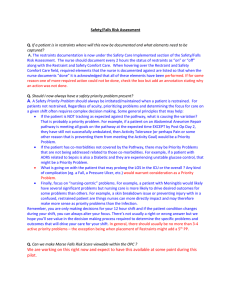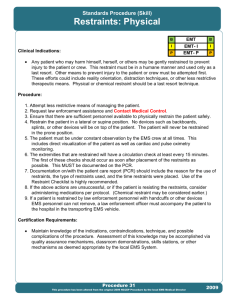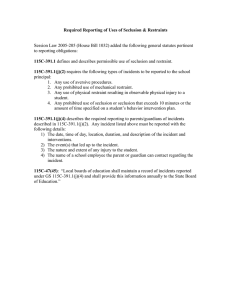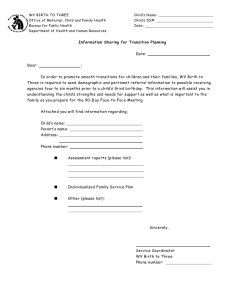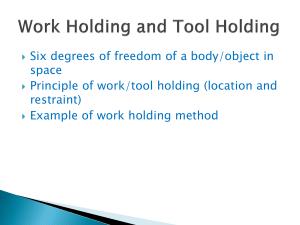Practice of restraining special needs students remains controversial, debate...
advertisement
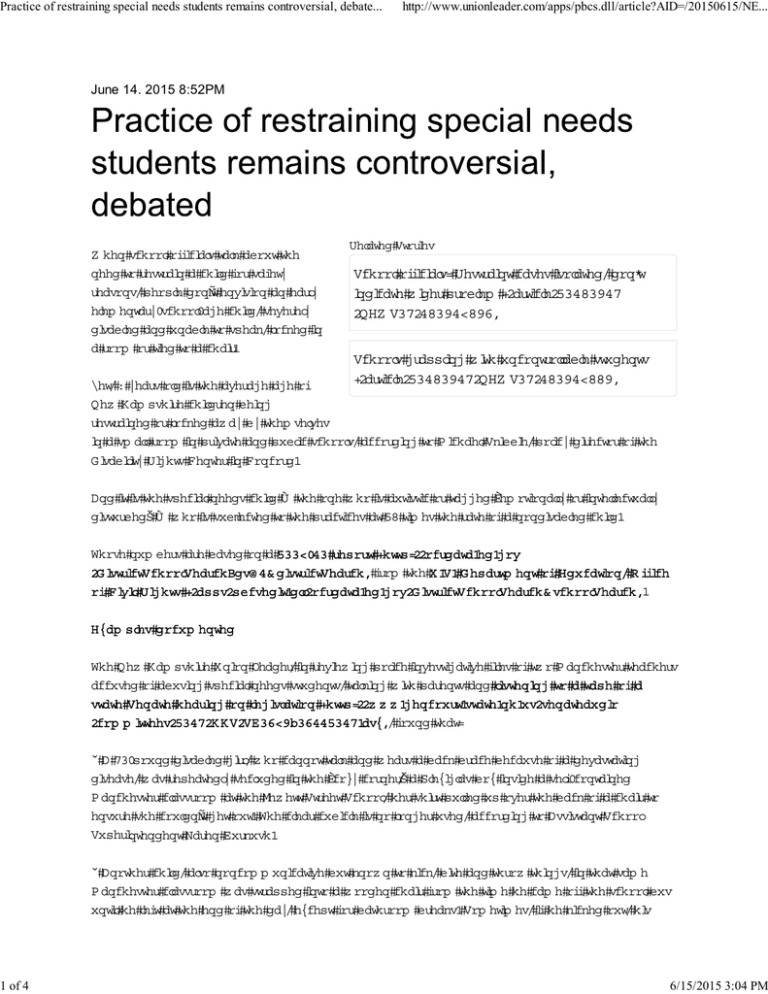
Practice of restraining special needs students remains controversial, debate... 1 of 4 http://www.unionleader.com/apps/pbcs.dll/article?AID=/20150615/NE... June 14. 2015 8:52PM W hen schoolofficials talk about the need to restrain a child for safety reasons,people don’t envision an early elem entary-school-age child,severely disabled and unable to speak,locked in a room or tied to a chair. Related Stories Schoolofficials: Restraint cases isolated,don't indicate w ider problem (/article/20150614 /NEW S04/150619563) Schools grappling w ith uncontrollable students (/article/20150614/NEW S04/150619556) Yet,7 years old is the average age of New Ham pshire children being restrained or locked aw ay by them selves in a sm allroom in private and public schools,according to M ichaelSkibbie,policy director of the Disability Rights Center in Concord. And it is the specialneeds child — the one w ho is autistic or tagged “em otionally or intellectually disturbed” — w ho is subjected to the practices at 25 tim es the rate of a nondisabled child. Those num bers are based on a 2009-10 report (http://ocrdata.ed.gov /D istrictSchoolSearch?ds= 1# districtSearch) from the U .S. D epartm ent of Education, O ffice of Civil Rights (/apps/pbcsedit.dll/ocrdata.ed.gov/D istrictSchoolSearch# schoolSearch). Exam ples docum ented The New Ham pshire Union Leader,in review ing police investigative files of tw o M anchester teachers accused of abusing specialneeds students,talking w ith parents and listening to a tape of a state Senate hearing on legislation (http://w w w .gencourt.state.nh.us/senateaudio /com m ittees/2014/H H S/SB0396_03112014.asx),found that: • A 40-pound disabled girl,w ho cannot talk and w ears a back brace because of a devastating disease,w as repeatedly secluded in the “cozy corner,” a Plexiglas box inside a self-contained M anchester classroom at the Jew ett Street School,her shirt pulled up over the back of a chair to ensure she couldn’t get out.The clear cubicle is no longer used,according to Assistant School Superintendent Karen Burkush. • Another child,also noncom m unicative but know n to kick,bite and throw things,in that sam e M anchester classroom w as strapped into a w ooden chair from the tim e he cam e off the schoolbus untilhe left at the end of the day,except for bathroom breaks.Som etim es,if he kicked out,his 6/15/2015 3:04 PM Practice of restraining special needs students remains controversial, debate... 2 of 4 http://www.unionleader.com/apps/pbcs.dll/article?AID=/20150615/NE... legs w ere strapped dow n as w ell.This w as a regular occurrence. • Another nonverbalchild w as tied in a rocking chair for about half the tim e he w as in his self-contained classroom at the Henry J.M cLaughlin School. • Another boy,w ho is autistic and cannot speak,and w ho w as in a public schoolin Rindge,w as routinely locked in a sm allroom w hen he got upset w hile the teachers stood outside w atching him . State legislators know about the issue. Sickens parent “This breaks m y heart and m akes m e sick because had the teachers not told m e about them installing the lock on the door and locking him in there (after the fact),he w ould never been able to tellm e,” the m other w rote legislators. “I feelbetrayed,know ing it appears the best w ay of handling (nam e deleted) in their opinion w as locking him up.The harm done by this is alm ost irreparable.” • At Rochester M iddle School,an 11-year-old boy w as restrained 13 tim es in less than a m onth after his parents signed a “safety of others” restraint perm ission form that schoolofficials told them w as needed,his parents w rote the legislators.They rescinded their perm ission after learning the restraints w ere used for noncom pliance situations — discipline — and not for safety reasons. According to the U.S.Departm ent of Education O ffice of CivilRights,students w ith disabilities represent 12 percent of the student population but account for 58 percent of those placed in seclusion or involuntary confinem ent,and 75 percent of those physically restrained at schoolto im m obilize them or reduce their ability to m ove freely. “It is quite pervasive,” Skibbie said of schools using the controlm easures.“I think it’s pretty w idespread.” And it can be dangerous,he said. N ot com m on practice Allen Pardy of the New Ham pshire Association of SpecialEducation Adm inistrators believes a sm all proportion of children are restrained and that the practice of using restraints and seclusion is not w idespread. Pardy said the enactm ent of RSA: 126U (http://w w w .gencourt.state.nh.us/rsa/htm l/x/126u/126-u-m rg.htm ) last Septem ber regarding restraints and seclusion has “really changed the gam e.” A legislative com m ittee,w hich also includes representatives state Health and Hum an Services 6/15/2015 3:04 PM Practice of restraining special needs students remains controversial, debate... 3 of 4 http://www.unionleader.com/apps/pbcs.dll/article?AID=/20150615/NE... Departm ent (DHHS),is w orking on the rule-m aking process. “It’s very com plicated because the DHHS is involved and they have their ow n rules and interpretations,” Pardy said. Legal requirem ent The law requires educators to file reports w henever a child is restrained or secluded,and lim its restraint uses to em ergency situations. At least 20 children died nationw ide from being restrained,according to a 2009 report by the U.S. Governm ent Accountability O ffice.Skibbie said that hasn’t happened in New Ham pshire,but there have been about a half dozen incidents of children suffering broken bones. There is no federallaw about restraining or secluding schoolchildren,and law s differ from state to state. Restraints can be w hen a teacher hugs a child or holds the child in a w ay to prevent m ovem ent untilan out-of-controlsituation de-escalates.At tim es,it can m ean strapping a child into a chair. Skibbie said in one unintentionalcase,an adm inistrator pulled a child by the arm and caused a serious shoulder injury. Incidents decline DRC Executive Director Richard Cohen said that,for the past three calendar years,the center has received 27 intakes about the use of restraints or seclusion across 12 schools,facilities or program s. That is a dow nw ard trend since 2010 w hen a law concerning the use of restraints in schools w as enacted,he said. That law did not address the issue of seclusion,but the recently enacted law does,and w hile it doesn’t ban the controversialpractice,it lim its its use to em ergencies. “It’s happening every day allover the country,” said Dan Habib,film m aker at the Institute on Disabilities (IO D) at the University of New Ham pshire in Durham . Habib m ade a film called “Restraint and Seclusion: Hear O ur Stories” that recounts experiences of form er students w ho w ere restrained and secluded w hile in public schools across the country and the physicaland em otionalinjuries they suffered as a result. “The reason I m ade that film w as to show just how devastating it is,” said Habib,w ho w on an Em m y in 2010 for his film “Including Sam uel.” “It w as to show that anything you can do to avoid the use of restraints or seclusion is the best path.” 6/15/2015 3:04 PM Practice of restraining special needs students remains controversial, debate... 4 of 4 http://www.unionleader.com/apps/pbcs.dll/article?AID=/20150615/NE... O pposed changes The New Ham pshire SchoolBoards Association (NHSBA),as w ellas the New Ham pshire School Adm inistrators Association,both opposed changes to the legislation. Barrett Christina,NHSBA staff attorney,said m em bers’concern w as that the law w as confusing for schooldistrict staff to understand and im plem ent. The definition of restraints,he said,w as so overbroad that any tim e a staff m em ber needed to touch a child,for instance,leading him to the principal’s office,w ould be conceived as restraints. Skibbie said the law m akes it clear that is not the case and that educators can restrain students w hen they or som ebody else is at risk. W hat the law now requires,how ever,is a w ritten report about the incident and notification the sam e day to a parent or guardian about w hat happened. Joanne M alloy,also of the Institute on Disabilities,is a nationalexpert in the use of Positive BehavioralInterventions and Supports,an approach that doesn’t use restraints and seclusion. It involves individualplans for challenging students — those that can be out of control,aggressive, disruptive — using a positive strategy and giving the student positive feedback. Science,she said,has proven the technique w orks. “It’s a com plex issue,” she said.“Schools don’t necessarily have the staff w ith the expertise in teaching children w ith aggressive and unsafe behavior.” Concluding part Tuesday pgrossm ith@ unionleader.com 6/15/2015 3:04 PM
